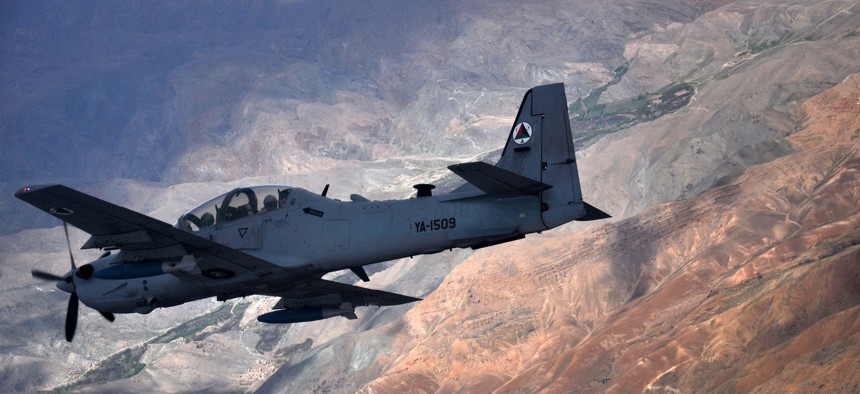
Capt. Eydie Sakura/U.S. Air Force
How to Sell a COIN Aircraft in a Great-Power Era
Even as the Pentagon shifts its focus from low-intensity conflict to full-spectrum war, the U.S. Air Force might finally buy a prop-driven light attack plane.
With the National Defense Strategy shift to great-power competition — and Defense Secretary Jim Mattis’ ubiquitously quoted “three lines of effort” — it’s no surprise that the defense industry has been tailoring marketing messages to suit. Perhaps more surprising are the pitches for the kinds of weapons that would have been perfect for the past 17 years of counterinsurgency warfare.
Exhibit one: The U.S. Air Force’s Light Attack Experiment, an ongoing evaluation of two bomb-carrying turboprop aircraft. They’re the types of planes that would have been perfect for supporting combat operations in Afghanistan and Iraq. Such planes would also have saved tons of wear and tear on the far more expensive F-15E and F-16 fighter jets, designed for high-end combat but pressed into service against low-end foes. Some in the Air Force wanted the planes back then, but service leaders never found funding. (I explored this at greater length in Air Force Magazine’s January 2010 issue).
Now, as the Pentagon shifts its focus to better preparing for war with Russia or China, some predict that the Air Force will buy hundreds of these small turboprop planes. Why, you might ask? First off, the fight against terror groups — whether it’s the Taliban, al Qaeda, Boko Haram, al Shabaab, or insert-insurgent-group here — isn’t expected to go away.
“There are some that argue that we should focus instead on the big fight — what may happen if we have a near-peer competitor or peer competitor in the future. I would argue that the A-29 is important no matter what perspective you take,” said Taco Gilbert, a retired Air Force brigadier general who works for Sierra Nevada Corp., which is trying to sell the A-29 Super Tucano to the Air Force.
Built by Brazil’s Embraer, the plane is flown by more than a dozen nations, largely in the developing world. Sierra Nevada and Embraer build Super Tucanos for the Afghan Air Force in Jacksonville, Florida. (The A-29's competitor in the Light Attack Experiment is Beechcraft's AT-6B Wolverine.)
“These fights are not going to go away, but we cannot afford as taxpayers and as warfighters to squander our fourth- and fifth-generation fighters’ service lives in these permissive and semi-permissive environments. They’re far too expensive,” Gilbert said on a call with reporters earlier this week.
The second argument for the planes — strengthening alliances — is one of Mattis’ three priorities.
Since a turboprop plane is less expensive to buy and “a little less complicated to operate” than higher-performance fighter jets, it “will give us more of an opportunity to have a broader group of nations be part of working with us and using this airplane,” said Gen. Ellen Pawlikowski, the head of Air Force Materiel Command, the arm of the service that oversees acquisition. She spoke at a Defense Writers Group breakfast this week.
And in general, the U.S. likes its allies and partners to buy similar weapons.
“[W]hen we buy something, it’s more likely that they’ll be interested in buying it,” Pawlikowski said. “That will allow us also to get the economy of scale by having more of them purchased as well as more of a global support structure for the supply chain, which will be attractive to them as much as it is to us.”
Argument three: buying cheaper planes allows the Air Force to buy more of them — and to train enough pilots to fill a current shortage.
“Now certainly, if we get into a peer or near-peer competitor fight, then this not the aircraft that you want to fly in that environment,” Gilbert said. “However, if we insist on using only fourth- and fifth-generation fighters going forward, we will never develop the number of fighter pilots that we need to support that peer or near-peer fight.”
Will this summer’s light-attack flyoff turn into an actual purchase? It seems like the project has enough steam. There’s support in Congress too. The House Armed Services Committee, in its review of the 2019 defense authorization bill, called on the Air Force speed up the project.
So that’s one way to pitch a COIN-focused weapon to a great-power-oriented Pentagon. We’ll look for others at the Special Operations Forces Industry Conference in Tampa next week.




